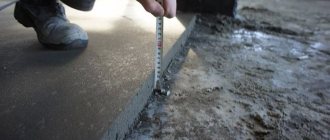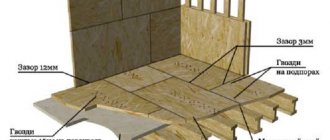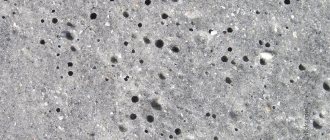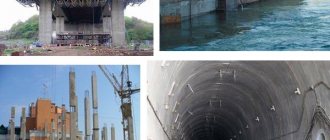Today, manufacturers of materials intended for flooring, especially in industrial construction, suggest using concrete.
This building material has performance characteristics that, despite its seemingly durable appearance, require additional strengthening.
Benefits of coverage
Topping is a strengthening mixture that is used to strengthen the top layer of the surface. Floors with hardening (topping) are used in industrial premises, car service stations, hangars, and shopping centers. Strengthening means the introduction into the top layer at the concreting stage of dry mixtures and fillers that add strength to the solution. Depending on the load, the following fillers are selected:
- quartz is suitable for medium load;
- Corundum materials are suitable for high loads;
- metal particles withstand heavy-duty loads.
The hardened surface has undeniable advantages:
- Resistance to shock loads and mechanical damage. Compliance with the correct technology prevents chips, potholes, and deformations.
- High wear resistance. Correctly applied composition increases the service life of a concrete floor by five times.
- No dust, no reaction to chemicals, ability to withstand the effects of gasoline, motor oils, diesel fuel.
- Decorative surface. A variety of fillers gives the floor a beautiful texture.
- Meets hygiene requirements and is easy to clean.
- Has antistatic properties, no sparks.
Return to contents
Types of used hardeners
In the practice of construction work to strengthen concrete coatings, two main technologies are used - applying dry reinforcing compounds (toppings) to a freshly laid floor, or impregnating the concrete floor with special mineral or organic compounds that strengthen the structure of the crystal lattice of the material.
Topping
The topping technology is in many ways similar to the “iron-plating” method known to most, when freshly laid concrete is rubbed with dry cement.
However, the “iron” layer is not particularly strong, which cannot be said about modern hardening mixtures. In addition to high-quality Portland cement, they contain special chemical additives that improve the structure of the surface layer of concrete, and fine filler, which largely determines the strength and texture of the future floor surface.
- Quartz hardeners are among the most common and affordable.
They use fine-grained purified quartz sand as a filler, which is often given a special decorative effect by introducing special coloring pigments.
This topping for concrete floors is the most widespread - it is used everywhere where floors are subject to medium load.
These can be production and warehouse premises, shopping and cultural centers, educational and medical institutions.
This method of strengthening is also used in residential construction, for example, in rooms with increased load on floors or high humidity - swimming pools, baths, gyms, etc.
The use of quartz topping makes it possible to increase the strength of a concrete coating by approximately one and a half times. In addition, the use of toppings of different shades gives scope for design creativity.
- Corundum hardeners contain corundum chips in their component composition - a mineral material characterized by the highest strength and resistance to abrasive abrasion.
Its use increases the resistance of floors to mechanical load by 1.6 - 1.8 times, and the resistance to abrasion - even up to 2 times, which determines the scope of application of such hardeners.
These are premises with installed heavy equipment or with heavy traffic of people or vehicles - social facilities, warehouse complexes, gyms, etc.
It has a corundum topping for concrete and good decorative qualities - it gives the coating an interesting matte shine.
- Toppings with metallized filler are considered the most durable.
Their use doubles the strength of the concrete coating due to the content of fine metal shavings.
Scope of application: industrial construction, where particularly massive equipment is installed, the movement of heavy equipment is planned, or other serious mechanical and vibration loads are possible.
They are not used in housing or social construction.
This is partly due to the redundancy of such hardening of the concrete screed, as well as for hygienic and aesthetic reasons - the metallized coating may become covered with traces of corrosion products at high humidity.
Chemical hardening – impregnations for concrete
This technology uses a different principle of hardening the concrete surface. As already noted, the structure of the crystal lattice of the material is extremely heterogeneous, saturated with substances that are unbound or only partially bound to it.
Exposure to certain chemicals creates additional crystalline bonds. They, intertwining and interacting with the basic structure of concrete, give it special strength qualities.
There is a special name for such impregnations for strengthening concrete - sealers. Their component composition can be quite diverse and be of mineral or organic origin.
Penetrating into the pores, capillaries, microcracks of concrete, they neutralize chemically active compounds, forming a kind of gel, which, expanding and filling all the voids, monolithizes the coating, prevents dusting, erosion, and increases resistance to abrasive abrasive load.
In addition, the created layer gives the concrete coating excellent waterproof properties.
This technology has many advantages. This is the relative simplicity of the hardening process, and, most importantly, the possibility of carrying out restoration and surface hardening of old concrete in service, worn-out coatings without dismantling them.
Correct use of technology
Scheme for laying concrete floors with a reinforced top layer.
Strengthening a concrete surface is a responsible and complex task. To perform it, you will need experience and special equipment. If the procedure is violated, changes are possible: cracks, peeling.
Concrete mixtures for coating are prepared in the generally accepted manner. The thickness of the layer and the procedure are no different from ordinary laying of concrete floors. Distinctive features arise at the final stage of processing. Work is carried out with the top, freshly laid concrete thickness. After going through the leveling process, the solution is treated with reinforcing compounds. Hardeners can be dry or liquid.
Topping – strengthening with dry compounds. The composition of the dry mixture includes: Portland cement, wear-resistant filler, additives, color component. The mixture is distributed evenly over the entire surface, compacted and smoothed with the blades of a construction machine. The final effect is hardened surfaces with increased wear resistance, no dust and a beautiful appearance.
Return to contents
Why is concrete hardening required?
First of all, a few words about the structure of concrete. It is a conglomerate mixture, as it consists of several completely dissimilar materials that differ in both chemical composition and size. The crystal lattice of cement stone created during the maturation process is intersected by solid insoluble inclusions of filler - sand or gravel.
If you examine a section of a mature concrete surface under a microscope, you will see that it has a pronounced porous structure - from micropores containing the gel substance of cement to macropores and capillaries filled with unbound water or air, and also having the ability to absorb atmospheric moisture.
Thus, in seemingly monolithic concrete, all three states of matter are always present - solid, gaseous and liquid.
Such a structure inevitably causes erosion processes on the surface of the coating, especially where it is subject to constant mechanical loads, temperature changes, exposure to precipitation or high humidity, and contact with aggressive chemicals.
As a result of erosion of the surface layers of the concrete coating, it begins to dust, crumble, crack, erode, efflorescence, areas of increased looseness, unevenness, etc. may appear on it.
It is almost impossible to completely change the physical and chemical structure of concrete, but to significantly improve the performance characteristics of the coating is a completely feasible task.
For this purpose, a number of technologies are used to harden, remove dust from the concrete surface, grind concrete floors and polish them. All these techniques, as a rule, are closely interrelated and, most often, are carried out in combination. However, it is better to consider them separately, and in this publication attention will be focused on the issues of strengthening the top layer of concrete.
Where hardening of concrete floors is most widely used:
- Production workshops of industrial enterprises.
- Warehouse and logistics complexes.
- Garages and equipment parking.
- Rooms with high humidity or a high probability of exposure to chemical reagents.
- Industrial premises where technology requires completely eliminating contact of cement dust with raw materials or manufactured products, for example, in food industry enterprises.
- Objects of the socio-cultural sphere, education and healthcare, which are characterized by a constant flow of people.
What advantages does the technology bring:
- The wear resistance of the coating increases significantly, and its surface strength increases.
- The floor receives reliable protection from dust formation.
- The water resistance of the coating and its overall moisture resistance increases.
- Service life increases.
- The overall cost of construction work is reduced - it is possible, without losing the quality of the coating, to use concrete of a lower grade.
- The decorative qualities of the concrete floor are improved. Some types of concrete hardeners allow you to create mosaic compositions on floors.
- Maintenance of a reinforced concrete base is much easier.
Topping application method
The difficulty of working with concrete floors lies in the stages.
Return to contents
Prepare the base
Pouring the concrete base.
The strength of the entire complex, the endurance of the hardened layer and the service life without repair depend on the quality result of the work performed. Compaction can be done on a sand-crushed stone base or on a concrete platform. First, to avoid damage to the main components of the coating, the base is leveled and compacted:
- Waterproofing. No concrete floor is possible without a layer of waterproofing. Using a film to prevent moisture from penetrating between the base and the freshly laid concrete layer. In individual cases, it is possible to install vapor barrier, sound insulation, and drainage layer.
- Reinforcement. According to the design documentation, the expected load should increase the strength of the concrete. To increase the load-bearing load, a reinforced frame is made. The work uses reinforcement, mesh or a mixed method, which gives bending or tensile strength.
Return to contents
Receiving concrete
Having prepared the formwork, reinforced frame, and taken care of the waterproofing layer, we begin laying the concrete mixture. The type of construction, transportation, and installation influence the choice of the type of mixture. The grade of concrete for floors with a reinforced top is chosen not lower than M300. It is not always possible to supply the solution to the workplace without problems; a concrete pump is very often used. It is important not to allow a time difference between the supply of batches; a constant supply of the mixture must be organized.
Return to contents
Compaction and leveling
Compacting the concrete mixture with a vibrating screed.
The procedure is performed with a construction vibrator using “liquid beacon” technology. The tool should be used carefully to prevent stratification of the solution. First, you should place the guides under the tool at the zero level and align them horizontally. Being careful in your work will help you avoid knocking them down.
The concrete solution is pumped onto the base at a level above the tool. By moving the vibration mechanism along the guides, the solution is leveled. The concrete mixture, under the influence of vibration, sags and levels out. In places where there is not enough solution, where it falls below the vibration rack, it is added with a spatula.
Return to contents
Layer hardening
Having gone through the stages of laying out, compacting, and leveling, it is necessary to take a technological pause, during which the concrete acquires durable characteristics. The hardening process takes from two to seven hours, the hardening time depends on humidity and air temperature:
- Grout. During this time, the solution reaches a minimum strength, and when you press on the floors, your foot leaves an imprint up to 3 mm deep. The surface is ready for processing with a special machine with discs.
- First application of the dry mixture. Topping (dry sealing mixture) is applied to the compacted surface in an amount of 50-60% of the total required amount.
- Grout. The dry composition completely absorbs moisture from the solution and becomes dark. The time has come to carry out the first grouting with a special machine. It is worth starting work from doorways and walls. The grouting process occurs until the dry mixture is completely mixed with the cement liquid, the surface concrete.
- Second application of the mixture. Having finished rubbing the first batch of the mixture, urgently add the remaining dry sealant. The topping must have time to absorb moisture before it evaporates. The second time, the inaccuracies in the distribution of the mixture after the first pass are taken into account.
- Grout. The darkened seal shows that it is necessary to begin the grinding process. In necessary situations, the procedure is repeated several times.
Return to contents
Grinding
Final grinding is done using a rotary shaft. Excellent results are achieved in several stages. The frequency of repetitions depends on the condition of the base. At the end of the procedure, the floors become smooth, matte, and do not leave a mark when touched.
Return to contents
Protective layer
A special protective agent is applied to the sanded surface. Its use is necessary to create conditions for the care of concrete floors. Applied in a thin layer, the composition prevents rapid evaporation of moisture. A simple procedure allows you to achieve strength, absence of dust, and wear resistance.
Return to contents
Shrink seams
Three days after completion of work, it is important to make temperature-shrinkable seams. They compensate for temperature processes during hardening and changes in the slab during operation. The process diagram is taken into account in the design documentation.
Return to contents
Hermitization
Three weeks after cutting, the seams are cleaned of dust, filled with a special sealant and hermetic paste.
Return to contents
What is the price?
We bring to your attention our price list for pouring industrial concrete floors with a reinforced top layer (topping).
| Price list for concrete floors with topping |
Our specialist will calculate the exact cost of topping floors for you after reviewing the technical specifications.
Do you need an exact flooring cost?
Send a detailed task or project by email
! Our specialists will make a calculation for you
Common Mistakes
When using a strengthening mixture, a number of mistakes are often made:
- dry compactor is not used if the concrete contains superplasticizers, additives with saline solution;
- do not withstand the mandatory technological break;
- ignoring reinforcement or violating the procedure for laying embedded connections to maintain load differences;
- inconsistency between the timing of cutting and the depth of expansion joints;
- “savings”, incorrect selection of material.
Return to contents
Varieties
The construction industry offers dry and liquid floor toppings, differing in application technology:
- powder mixtures are scattered over the surface of fresh concrete, rubbed and thoroughly polished;
- Liquid compositions contain water; they are poured, leveled and allowed to dry completely, then the surface is sanded.
In the classical sense, toppings are dry substances rubbed into the surface. Liquid ones are more often called sealers.
In the manufacture of hardeners, the following abrasive materials are used as fillers:
The inclusion of basalt, iron or silicon carbides, and titanium oxide gives the toppings specific properties. Plasticizers improve the workability of mixtures, and antifreeze additives are used to increase frost resistance.
Advantages and disadvantages
The use of concrete with a top layer of topping has the following advantages:
It is worth noting that topping only improves the properties of the concrete coating. Therefore, for work you need to choose high-quality concrete of a grade higher than M300.
Excess water in concrete will cause deformation for the top layer when drying. A lack of moisture will lead to an increase in the drying time of the topping; it will be loose and unevenly dried.
If the concrete is dirty or dusty, the applied topping may peel off.
The final appearance of the topping will depend on the uniformity of its installation and grouting. If the work is done incorrectly, restoring and repairing the topping will be expensive.
Work examples
Installation of 850 m 2 of concrete floor with topping in Nizhny Novgorod.
Kawabanga! Winter concreting
Pouring an industrial floor with topping with an area of 576 m2 in a car service building.
Installation of a topping floor in a warm hangar in the Nizhny Novgorod region.
Filling 1000 sq. m of concrete floor with topping in Nizhny Novgorod. The entire complex of work on pouring the floor on a turnkey basis was completed at the site.
The first stage is installation of concrete preparation
In general, the underlying layer can be flexible or rigid. In the first case, these are sand, gravel, crushed stone, and asphalt concrete bedding. This technology works successfully in industrial and private construction, subject to high-quality compaction, preferably with the participation of mechanical rollers. On dry soils, it is permissible to install a clay concrete underlying layer .
The thickness of the underlying layer is selected based on the type of expected loads, soil properties, and materials used
Rigid concrete preparation is required on floors with the following operating conditions:
- exposure to aggressive liquids;
- exposure to organic solvents, substances of animal origin;
- humidity, action of water, oils, solutions.
According to current standards, the minimum thickness of the underlying layer is accepted as follows:
- sand cushion – 60 mm;
- gravel/crushed stone cushion – 80 mm;
- hard concrete layer – 80 mm – in public/residential premises, 100 mm – in production.
If a decision is made to install rigid preparation, class B22.5 concrete is used. If the calculated loads on the base are lower and the required load-bearing capacity will be provided, it is permissible to take a lower class, but not less than B7.5.
If sudden temperature changes are possible in the room where work will be carried out, it is necessary to provide for cutting expansion joints. The seams are cut mutually perpendicular, in increments of 8-12 m . They must coincide with the general expansion joints of the object, and in areas with organized drainage, for example, in garages, with the watershed of the floors.
When laying soil foundations for concrete preparation, proceed as follows:
- remove a layer of plant soil. If necessary, lower the groundwater level. The technology requires drying of saturated soils (clays, loams), which will restore their design bearing capacity;
- if the floor is laid on heaving soils, they will be protected from deformation in unheated rooms;
- finely porous soils are replaced with soils with low settlement or are well consolidated;
- soils with a disturbed structure and bulk soils should be cleaned of impurities and compacted with tampers. If the equipment can cause displacement or damage to foundations and adjacent structures, the soil is compacted manually in layers of 10 cm.
The sand cushion is poured only on a leveled soil base. The material must be laid in a continuous, even layer. Thickness – 5-10 mm. Requires sealing. To ensure high quality work, the surface is moistened by 7-10%.
If crushed stone is used as the underlying layer, it is also applied to the leveled base. The material is selected according to its granulometric composition and moistened by 5-7% .
Crushed stone, like sand, is laid in uniform continuous layers. Optimal thickness – 80-200 mm
The layer is leveled and compacted. For large volumes of work, mechanical rammers weighing 8 tons are used, for small volumes - manual ones. The crushed stone must be compacted so that a dense, even layer is obtained . Only in this case can we talk about uniform distribution of the load from the floor structure to the ground.
Safety precautions
All workers must be familiar with the work project and the organization of the workplace. Training in the safe handling of machinery and tools must be provided. Familiarization with the materials used and the features of the work is carried out. Instruction on safety regulations, fire safety standards, and industrial sanitation is required. During the briefing, they are guided by SNiP “Safety in Construction”.
The work must be carried out using serviceable technological equipment (containers, devices for lifting, grabbing materials, piece materials, bulk materials). Collective and individual protective equipment must be used. Separate areas are provided for storing materials and tools.











